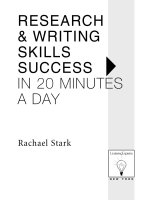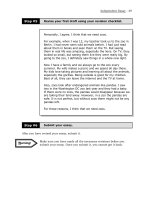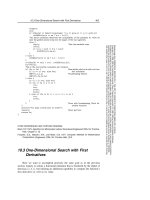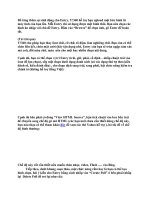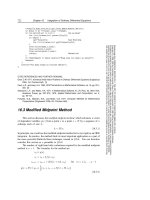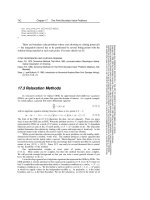Tài liệu RESEARCH AND WRITING SKILLS SUCCESS PART 4 ppt
Bạn đang xem bản rút gọn của tài liệu. Xem và tải ngay bản đầy đủ của tài liệu tại đây (63.07 KB, 7 trang )
19.
The purpose of writing an outline for
your research paper is to
a. assemble every single idea in
alphabetical order.
b. follow a fixed sequence of page
numbers that do not change.
c. provide a step-by-step guide and
overview that links your main points
visually on one page.
d. allow you to order events in a
chronological arrangement.
20.
A thesis statement is
a. an opinion.
b. a conclusion.
c. the primary argument of your paper.
d. the analysis or evidence provided in
your paper by a professional
journalist.
21.
A preliminary outline is
a. a final version of your paper.
b. a beginning or first draft of your
outline.
c. the conclusion of your paper.
d. an abstract of all your relevant
information.
22.
You can include direct quotes from
authorities and speeches in your paper as
long as you
a. explain to your reader why this
material may be opinionated.
b. analyze whatever you include.
c. state how and why they are important.
d. cite the specific context from which
they were taken in your footnotes,
endnotes, or parenthetical citations.
23.
Brainstorming is a useful process because
it allows you to
a. type your final draft more quickly.
b. jot down many ideas that you can
refer to later.
c. interview another professional.
d. write several rough drafts of your
entire paper.
24.
Using evidence in your paper to support
your thesis statement is important. The
term evidence refers to
a. statistics, illustrations, speeches, or
direct quotes that prove your
argument.
b. your opinions and ideas about the
topic.
c. what your professor thinks of your
work
d. a convincing introductory sentence.
25.
When you use the Internet to help you
do your research, an established website
or search engine is
a. an electronic site with an
accompanying address that helps you
search for specific information.
b. a university website.
c. a website that a librarian helped you
to locate.
d. a site that has all the information you
need on its home page.
–
PRETEST
–
8
26.
A thesis statement should always be clear
and written
a. at the very beginning of your research
paper, preferably in the introduction.
b. at the end of the endnote page.
c. in the table of contents.
d. in a separate bibliography.
27.
The sentence, “Kennedy was a really cool
president,” is a good example of
a. shrewd analysis.
b. direct reasoning.
c. secondary information.
d. colloquial or informal writing.
28.
Which of the following statements is the
most convincing way to begin a research
paper?
a. “I think you should listen to the
evidence that I will present to you.”
b. “I feel that you should listen to the
evidence that I will present to you.”
c. “The evidence presented will
demonstrate that . . .”
d. “I believe this evidence is important
because . . .”
29.
It is important for a writer to have
opinions. However, when you are writing
a paper, it is always better to
a. state more opinions than facts.
b. word your opinions strongly.
c. tell the reader your opinion with
informal and friendly writing.
d. support your argument or thesis
statement with facts.
30.
Similar to having strong opinions, a
writer’s emotions
a. should not be stated openly to the
reader but instead demonstrated and
proved by the evidence.
b. should be obvious.
c. should be worded with extreme
caution.
d. should be documented with notes or
citations, and a formal bibliography.
31.
A work of non-fiction is based upon
a. historical legend and folklore.
b. facts and real-life occurrences.
c. anecdotes and stories.
d. a lot of textual evidence.
32.
A work of fiction
a. uses historical facts to shape a story.
b. provides interesting statistical data.
c. is based upon hard core evidence.
d. is a product of the writer’s
imagination and may, but does not
necessarily, incorporate factual
material.
33.
An annotated bibliography
a. is not alphabetized.
b. contains valuable insights.
c. provides a brief summary of the
books that were helpful during
research.
d. is part of the final analysis of the
paper.
–
PRETEST
–
9
34.
A definitive statement
a. makes a clear, strong point to the
reader.
b. uses a lot of vivid and imaginative
detail.
c. contains many facts.
d. should be footnoted.
35.
Statistical information should always be
cited because
a. numbers should appear in a
bibliography.
b. facts can always be disputed.
c. hard data should appear at the end of
a paper.
d. a conclusion should always contain
statistics.
36.
In a bibliography, it is essential that
a. sources are arranged in chronological
order.
b. sources are grouped together by their
usefulness.
c. all sources are alphabetized.
d. sources are listed by category
according to whether they are primary
or secondary.
37.
An abstract typically accompanies
a. a scientific or mathematical paper.
b. an essay only.
c. a paper on any liberal arts topic.
d. a paper with a great deal of footnotes
or documentation.
38.
The tone of a writer’s work usually refers
to
a. the effectiveness of his or her writing.
b. the mood that is conveyed within the
work.
c. the instrumental sound of the
language.
d. the feelings that the writer has for the
reader.
39.
When a paper has an authoritative tone,
this means
a. the writer presents his or her material
knowledgeably.
b. the writer uses large vocabulary words
to impress the reader.
c. the writer includes colorful
illustrations.
d. the writer adds a long bibliography at
the end of the work.
40.
Unlike an opinion, a fact
a. is known to be true.
b. is believed to be true.
c. is something the writer wishes were
true.
d. is part of an anonymous legend.
41.
Footnotes and parenthetical citations are
important because
a. they prove that the writer has done a
lot of needless research.
b. they protect a writer from accusations
of plagiarism.
c. they make a writer seem intelligent.
d. they make a paper look more
professional.
–
PRETEST
–
10
–
PRETEST
–
11
42.
When listing books in a standard
bibliography, the correct procedure is to
a. list all the printing editions of the
books you have used.
b. alphabetize your books by the author’s
last name.
c. make sure the order of the books you
have listed corresponds with the order
of your footnotes.
d. write a corresponding list of the
books’ illustrations.
43.
Using formal language in your paper
means to
a. address the topic in a professional and
serious manner with language
reserved for scholarly work.
b. use very familiar words and language.
c. assume a tone of superiority.
d. become friends with your reader so
that he or she is eager to read your
paper.
44.
Common spelling errors are often found
when a spell check is completed;
however, this method is not infallible. To
be sure that you find all errors, you can
a. give your paper to your professor and
ask him or her to grade it in advance.
b. have a friend or a relative read your
paper to look for errors.
c. ask a librarian if he or she wouldn’t
mind checking your paper.
d. allow the computer to run a grammar
check at least three different times.
45.
The difference between an emotional and
a logical appeal is that a logical appeal
a. is written more carefully.
b. provides more reasonable arguments.
c. is based upon fact.
d. values the opinion of the reader.
46.
In order to find a topic for your paper, it
is often helpful to
a. copy an idea straight from a book.
b. ask yourself some basic questions like,
“who,”“what,”“where,”“when,” or
“why” about a particular subject that
interests you.
c. seek the advice of a guidance
counselor or other working
professional.
d. go to the librarian and ask him or her
for a list of popular topics.
47.
A primary source is valuable because
a. it provides a firsthand perspective
about the event, time period, or topic
you are researching.
b. it is the best source that a writer can
use.
c. it is the most documented and
respected type of source.
d. it is from a very distinguished and
respected individual.
48.
Using note cards to take down
information from books is helpful and
handy because
a. note cards can be arranged easily and
quickly and stored in one place.
b. note cards are a more respected way of
taking down information.
c. note cards look more professional
than large sheets of paper.
d. photocopying can leave dark marks
on paper.
49.
When writing footnotes, it is always
important to list them
a. in chronological order.
b. as a separate work from your note
cards.
c. with a corresponding reference sheet.
d. in your opening credits.
50.
A historiography provides
a. a thorough listing of all electronic
sources.
b. a summary of different ways of
historical thinking about a particular
topic over time.
c. a complete list of illustrations.
d. a list of acknowledgements at the
beginning of your paper.
–
PRETEST
–
12
